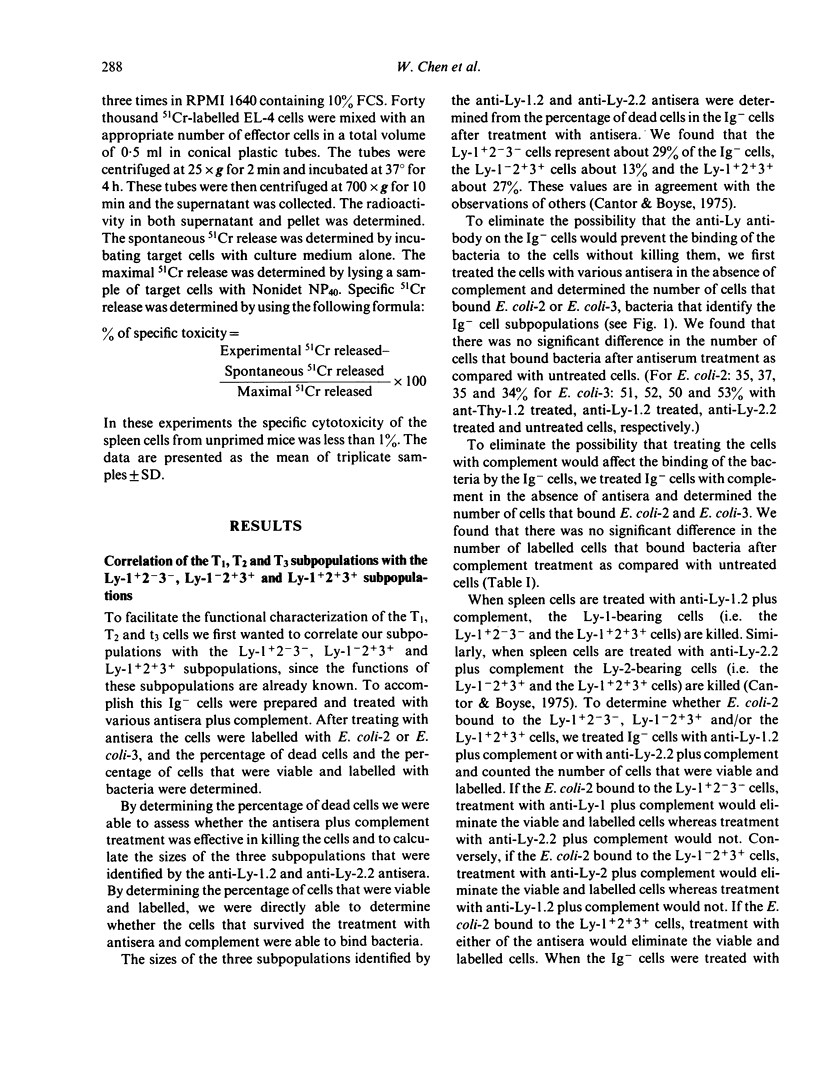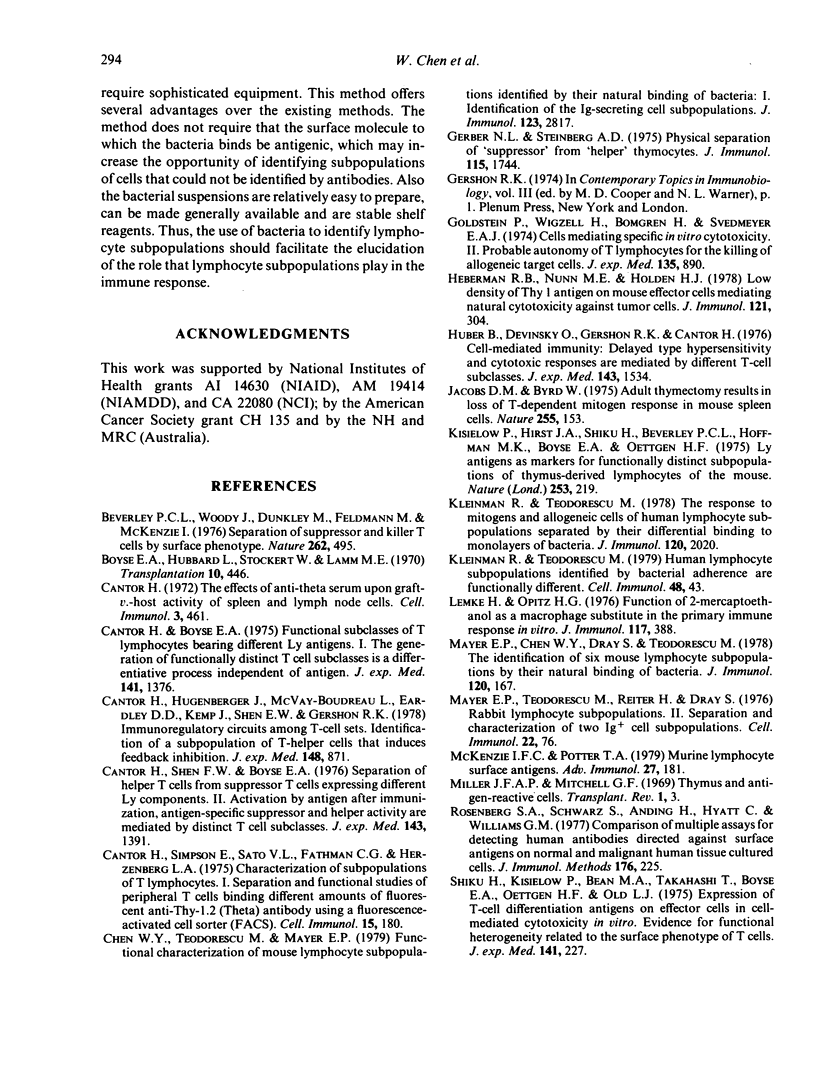Abstract
Three T-cell subpopulations (T1, T2 and T3) can be identified by their binding of various bacteria (Mayer, Chen, Dray & Teodorescu, 1978). In this work we determined how the three subpopulations identified by their Ly-1, -2 and -3 alloantigens were distributed among the T1, T2 and T3 subpopulations. We found that the T1 subpopulation contained most of the Ly-1+2+3+ cells, that the T2 subpopulation contained some Ly-1+2-3- and some Ly-1-2+3+ cells and that the T3 subpopulation contained the remainder of the Ly-1+2+3+, Ly-1+2-3- and Ly-1-2+3+ cells. Thus the subpopulations identified by their bacterial adherence properties subdivided the three subpopulations identified by their Ly-1, -2 and -3 alloantigens. We also investigated whether the specific cytotoxic T lymphocytes were contained in the T1, T2 and/or T3 cells. We found that essentially all of the cytotoxic T lymphocytes were contained in the T3 subpopulation. Since the T3 cells contained a subpopulation of Ly-1-2+3+ cells the data indicated that essentially all of the cytotoxic T lymphocytes were contained in a subpopulation of Ly-1-2+3+ cells.
Full text
PDF










Selected References
These references are in PubMed. This may not be the complete list of references from this article.
- Beverley P. C., Woody J., Dunkley M., Feldmann M., McKenzie I. Separation of suppressor and killer T cells by surgace phenotype. Nature. 1976 Aug 5;262(5568):495–497. doi: 10.1038/262495a0. [DOI] [PubMed] [Google Scholar]
- Boyse E. A., Hubbard L., Stockert E., Lamm M. E. Improved complementation in the cytotoxic test. Transplantation. 1970 Nov;10(5):446–449. doi: 10.1097/00007890-197011000-00019. [DOI] [PubMed] [Google Scholar]
- Cantor H., Boyse E. A. Functional subclasses of T-lymphocytes bearing different Ly antigens. I. The generation of functionally distinct T-cell subclasses is a differentiative process independent of antigen. J Exp Med. 1975 Jun 1;141(6):1376–1389. doi: 10.1084/jem.141.6.1376. [DOI] [PMC free article] [PubMed] [Google Scholar]
- Cantor H., Hugenberger J., McVay-Boudreau L., Eardley D. D., Kemp J., Shen F. W., Gershon R. K. Immunoregulatory circuits among T-cell sets. Identification of a subpopulation of T-helper cells that induces feedback inhibition. J Exp Med. 1978 Oct 1;148(4):871–877. doi: 10.1084/jem.148.4.871. [DOI] [PMC free article] [PubMed] [Google Scholar]
- Cantor H., Shen F. W., Boyse E. A. Separation of helper T cells from suppressor T cells expressing different Ly components. II. Activation by antigen: after immunization, antigen-specific suppressor and helper activities are mediated by distinct T-cell subclasses. J Exp Med. 1976 Jun 1;143(6):1391–1340. doi: 10.1084/jem.143.6.1391. [DOI] [PMC free article] [PubMed] [Google Scholar]
- Cantor H., Simpson E., Sato V. L., Fathman C. G., Herzenberg L. A. Characterization of subpopulations of T lymphocytes. I. Separation and functional studies of peripheral T-cells binding different amounts of fluorescent anti-Thy 1.2 (theta) antibody using a fluorescence-activated cell sorter (FACS). Cell Immunol. 1975 Jan;15(1):180–196. doi: 10.1016/0008-8749(75)90174-4. [DOI] [PubMed] [Google Scholar]
- Cantor H. The effects of anti-theta antiserum upon graft-versus-host activity of spleen and lymph node cells. Cell Immunol. 1972 Mar;3(3):461–469. doi: 10.1016/0008-8749(72)90251-1. [DOI] [PubMed] [Google Scholar]
- Chen W. Y., Teodorescu M., Mayer E. P. Functional characterization of mouse lymphocyte subpopulations identified by their natural binding of bacteria. I. Identification of the Ig-secreting cell subpopulation. J Immunol. 1979 Dec;123(6):2817–2822. [PubMed] [Google Scholar]
- Gerber N. L., Steinberg A. D. Physical separation of "suppressor" from "helper" thymocytes. J Immunol. 1975 Dec;115(6):1744–1745. [PubMed] [Google Scholar]
- Golstein P., Wigzell H., Blomgren H., Svedmyr E. A. Cells mediating specific in vitro cytotoxicity. II. Probable autonomy of thymus-processed lymphocytes (T cells) for the killing of allogeneic target cells. J Exp Med. 1972 Apr 1;135(4):890–906. doi: 10.1084/jem.135.4.890. [DOI] [PMC free article] [PubMed] [Google Scholar]
- Herberman R. B., Nunn M. E., Holden H. T. Low density of Thy 1 antigen on mouse effector cells mediating natural cytotoxicity against tumor cells. J Immunol. 1978 Jul;121(1):304–309. [PubMed] [Google Scholar]
- Huber B., Devinsky O., Gershon R. K., Cantor H. Cell-mediated immunity: delayed-type hypersensitivity and cytotoxic responses are mediated by different T-cell subclasses. J Exp Med. 1976 Jun 1;143(6):1534–1539. doi: 10.1084/jem.143.6.1534. [DOI] [PMC free article] [PubMed] [Google Scholar]
- Jacobs D. M., Byrd W. Adult thymectomy results in loss of T-dependent mitogen response in mouse spleen cells. Nature. 1975 May 8;255(5504):153–155. doi: 10.1038/255153a0. [DOI] [PubMed] [Google Scholar]
- Kisielow P., Hirst J. A., Shiku H., Beverley P. C., Hoffman M. K., Boyse E. A., Oettgen H. F. Ly antigens as markers for functionally distinct subpopulations of thymus-derived lymphocytes of the mouse. Nature. 1975 Jan 17;253(5488):219–220. doi: 10.1038/253219a0. [DOI] [PubMed] [Google Scholar]
- Kleinman R., Teodorescu M. Human lymphocyte subpopulations identified by bacterial adherence are functionally different. Cell Immunol. 1979 Nov;48(1):43–51. doi: 10.1016/0008-8749(79)90097-2. [DOI] [PubMed] [Google Scholar]
- Kleinman R., Teodorescu M. The response to mitogens and allogeneic cells of human lymphocyte subpopulations separated by their differential binding to monolyaers of bacteria. J Immunol. 1978 Jun;120(6):2020–2026. [PubMed] [Google Scholar]
- Lemke H., Opitz H. G. Function of 2-mercaptoethanol as a macrophage substitute in the primary immune response in vitro. J Immunol. 1976 Aug;117(2):388–395. [PubMed] [Google Scholar]
- Mayer E. P., Chen W. Y., Dray S., Teodorescu M. The identification of six mouse lymphocyte subpopulations by their natural binding of bacteria. J Immunol. 1978 Jan;120(1):167–173. [PubMed] [Google Scholar]
- Mayer E. P., Teodorescu M., Reiter H., Dray S. Rabbit lymphocyte subpopulations. II. Separation and characterization of two Ig+ cell subpopulations. Cell Immunol. 1976 Mar 1;22(1):76–82. doi: 10.1016/0008-8749(76)90008-3. [DOI] [PubMed] [Google Scholar]
- Miller J. F., Mitchell G. F. Thymus and antigen-reactive cells. Transplant Rev. 1969;1:3–42. doi: 10.1111/j.1600-065x.1969.tb00135.x. [DOI] [PubMed] [Google Scholar]
- Rosenberg S. A., Schwarz S., Anding H., Hyatt C., Williams G. M. Comparison of multiple assays for detecting human antibodies directed against surface antigens on normal and malignant human tissue culture cells. J Immunol Methods. 1977;17(3-4):225–239. doi: 10.1016/0022-1759(77)90105-3. [DOI] [PubMed] [Google Scholar]
- Shiku H., Kisielow P., Bean M. A., Takahashi T., Boyse E. A., Oettgen H. F., Old L. J. Expression of T-cell differentiation antigens on effector cells in cell-mediated cytotoxicity in vitro. Evidence for functional heterogeneity related to the surface phenotype of T cells. J Exp Med. 1975 Jan 1;141(1):227–241. doi: 10.1084/jem.141.1.227. [DOI] [PMC free article] [PubMed] [Google Scholar]
- Sullivan K. A., Berke G., Amos D. B. An antigenic determinant of cytotoxic lymphocytes. Transplantation. 1973 Oct;16(4):388–391. [PubMed] [Google Scholar]
- Teodorescu M., Mayer E. P., Dray S. Identification of five human lymphocyte subpopulations by their differential binding of various strains of bacteria. Cell Immunol. 1977 Mar 15;29(2):353–362. doi: 10.1016/0008-8749(77)90330-6. [DOI] [PubMed] [Google Scholar]
- Tigelaar R. E., Gorczynski R. M. Separable populations of activated thymus-derived lymphocytes identified in two assays for cell-mediated immunity to murine tumor allografts. J Exp Med. 1974 Jul 1;140(1):267–289. doi: 10.1084/jem.140.1.267. [DOI] [PMC free article] [PubMed] [Google Scholar]


